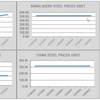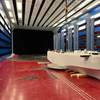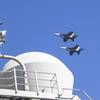USS Tortuga (LSD 46) arrived on March 31 after completing an 11,000-mile voyage across two oceans and transiting the Panama Canal for a scheduled hull swap with USS Fort McHenry (LSD 43).
Tortuga is the sixth Whidbey Island-class ship and will join Commander, Task Force (CTF) 76, serving as an integral part of the Navy’s Forward Deployed Expeditionary Strike Group (FD-ESG) and Forward Deployed Amphibious Ready Group (ARG).
“We are very excited to be here in Sasebo. For many of us, this is our first time in Japan,” said Cmdr. Mark H. Scovill, Tortuga’s commanding officer. “Along with conducting the hull swap, the crew has a great opportunity to experience the Japanese culture.”
Hull swap, or ship rotation, is part of the Navy’s long-range plan to routinely replace older ships assigned to the Navy’s Forward Deployed Naval Force (FDNF) with newer or more capable ships. Forward deployment of Tortuga ensures the ability of Commander, U.S. 7th Fleet to fulfill the U.S. government’s commitment to the defense of Japan and the maintenance of international peace and security in the Far East in support of the Treaty of Mutual Cooperation and Security.
In addition, Tortuga arrived with four Assault Craft Unit (ACU) 5 Western Pacific Detachment LCACs (Landing Craft Air Cushion) in the well deck to replace three older LCACs already here and adding an additional LCAC to ACU 5’s inventory. After completion of the hull swap, Fort McHenry will return to the United States with three of the older LCACs.
Commissioned in 1990, the dock landing ship has conducted numerous multinational bilateral training exercises, such as Dynamic Mix ’98 in the Mediterranean, Sardinia ’98 off the coast of Sardinia and UNITAS 2000 off the coast of Argentina. It deployed in 1996 to Liberia and in 2000 served as a maritime platform for Navy Construction Battalion and Marine Corps engineering personnel who helped the Venezuelans clear roads along the flood-ravaged Venezuelan coastline. Recently, Tortuga conducted emergent relief operations in support of Hurricane Katrina humanitarian assistance in September 2005.
“This hull swap is a win-win process for everyone involved. The Sailors and their families stationed here in Sasebo stay here and are not uprooted, while at the same time the Forward Deployed Naval Forces get a newer and more capable ship,” said Cmdr. Michael T. Talaga, Fort McHenry’s commanding officer. “Tortuga’s distinguished reputation and history will continue the legacy left behind by the Fort McHenry.”
Dock landing ships support a variety of missions to include amphibious assault operations to humanitarian relief operations. Fort McHenry and Tortuga can carry and operate helicopters, conventional landing crafts and LCACs, providing support as a sea base to its amphibious forces for an extended period of time.
Fort McHenry will depart Sasebo in April 2006 and return to Little Creek, Va., where it will be homeported.
The Navy’s first hull swap was conducted here in 1999 when USS Juneau (LPD 10) replaced the USS Dubuque (LPD 8). In 2000, USS Essex (LHD 2), the current flagship of the Forward Deployed Amphibious Ready Group, replaced the USS Belleau Wood (LHA 3). And in 2002, USS Harpers Ferry (LSD 49) replaced the USS Germantown (LSD 42).
The Forward Deployed ARG is part of Task Force 76, the Navy's only forward-deployed amphibious force, which is headquartered at White Beach Naval Facility, Okinawa, Japan, with an operating detachment in Sasebo, Japan.
Sponsored Content
Innovative Hull Maintenance: Profitable & Green

Subscribe for
Maritime Reporter E-News
Maritime Reporter E-News is the maritime industry's largest circulation and most authoritative ENews Service, delivered to your Email five times per week













